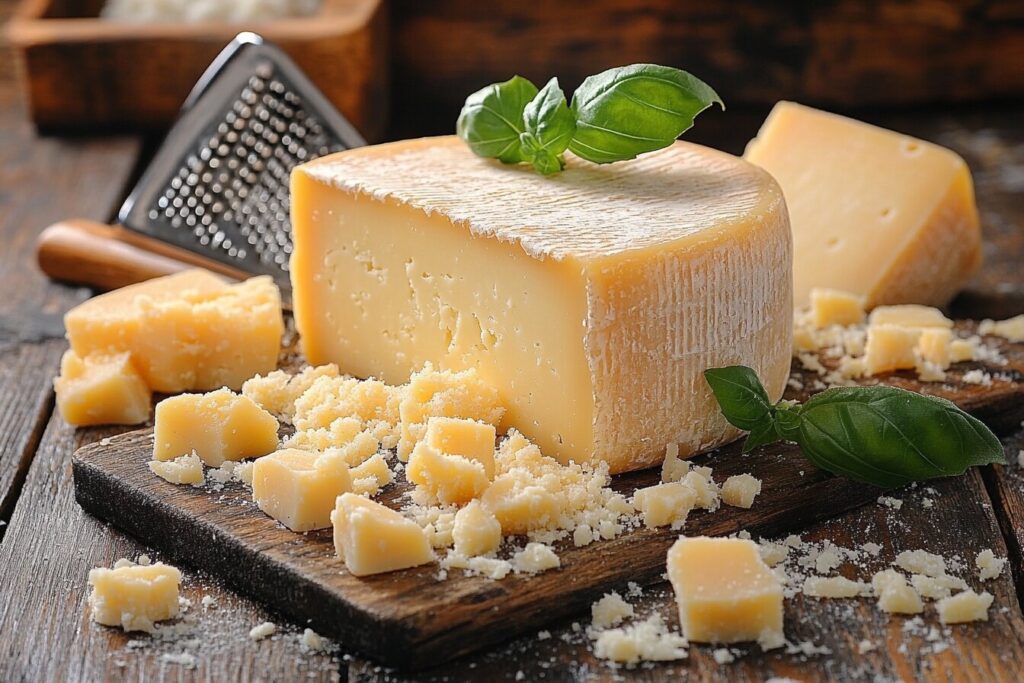The cheese parmesan wheel, or Parmigiano Reggiano, is more than just a block of cheese—it’s a culinary treasure with a rich history and unmatched flavor. From its origins in Italy to its versatility in the kitchen, Parmesan wheels are a must-have for food lovers everywhere. Curious about why these golden wheels are so coveted? Let’s dive into the world of Parmesan cheese wheels and uncover their secrets!
What is a Cheese Parmesan Wheel?
Have you ever come across a massive cheese Parmesan wheel and wondered what makes it so special? This culinary masterpiece, also known as Parmigiano Reggiano, is more than just a block of cheese—it’s a symbol of craftsmanship, history, and exceptional flavor. Loved by chefs and foodies alike, the Parmesan wheel is a staple in kitchens worldwide, thanks to its unique taste and incredible versatility. Let’s dive in and explore everything you need to know about this iconic cheese!
A Brief History of Parmesan Cheese
Ever wondered how parmesan cheese got its start? It dates back to the Middle Ages, where monks in Northern Italy began crafting this dense, flavorful cheese. The regions of Parma, Reggio Emilia, Modena, and parts of Bologna and Mantua became the home of Parmigiano Reggiano, giving it its iconic name. It’s been a staple in Italian cuisine for centuries and remains a symbol of quality and tradition.

How Parmesan Wheels are Made
The creation of a parmesan wheel is no small feat. It involves meticulous attention to detail and time. Here’s a simplified version of the process:
- Milk from grass-fed cows is heated and mixed with rennet.
- The curds are separated from the whey and molded into wheels.
- Wheels are salted and aged for 12-36 months, developing their signature taste.
Did you know? Each parmesan wheel can weigh around 80 pounds! That’s like carrying a small child.
Why Choose a Cheese Parmesan Wheel?
So, why would anyone want a massive wheel of cheese? Let’s break down the perks.
Unique Flavor and Texture
Parmesan wheels boast a flavor that’s both nutty and slightly salty, with a grainy texture that melts in your mouth. It’s the ultimate umami bomb for any dish.
Long Shelf Life and Versatility
Unlike many cheeses, a parmesan wheel can last for months if stored properly. Plus, its uses are endless: grating over pasta, making crisps, adding to soups, and more.
How to Store and Preserve a Parmesan Wheel
Storage is key to keeping your cheese fresh and flavorful. Let’s look at the do’s and don’ts.

Proper Temperature and Humidity
The ideal temperature for storing a parmesan wheel is between 39°F and 46°F. Wrap it in wax paper or a cheesecloth to allow it to breathe. Avoid plastic wrap, as it can trap moisture and cause mold.
Common Mistakes in Storage and How to Avoid Them
- Plastic Wrapping: Use breathable materials instead.
- Direct Sunlight: Store in a cool, dark place to avoid drying out.
- Freezing: While possible, freezing can alter the texture.
Using a Parmesan Wheel in Your Kitchen
A parmesan wheel isn’t just for show; it’s a kitchen MVP. Here are some practical ways to use it.
Grating Parmesan for Everyday Use
The simplest way to use your parmesan wheel? Grate it! Freshly grated parmesan elevates any dish, from pasta to salads. Invest in a good microplane for fine, fluffy shavings.
Creating Parmesan Bowls and Crisps
Want to get fancy? Melt grated parmesan in a non-stick pan, shape it into a bowl or crisp, and let it harden. These edible creations are perfect for soups, salads, or snacks.
How to Make Parmesan Broth
Don’t toss those parmesan rinds! Simmer them in water with herbs and veggies to create a rich, flavorful broth. It’s a zero-waste way to add depth to your soups and sauces.
| Nutrient | Amount |
|---|---|
| Calories | 110 |
| Protein | 10 g |
| Fat | 7 g |
| Carbohydrates | 1 g |
| Calcium | 336 mg |
Cheese Parmesan Wheel for Special Occasions
A Parmesan wheel isn’t just cheese; it’s an experience. For special occasions, it can steal the show as a centerpiece, conversation starter, or even a serving dish. Let’s dive into some ways you can wow your guests with this culinary gem.
Hosting a Cheese Tasting Party
Planning a gathering? A Parmesan wheel can elevate your cheese board to a whole new level. Surround it with other cheeses, fresh fruits, nuts, and cured meats, and let guests shave off their own slices. It’s interactive and oh-so-fancy!
Pairings matter too! Parmesan’s salty richness goes beautifully with wines like Chianti or Prosecco and balsamic vinegar drizzles.
Pro Tip: Use a small cheese knife to let guests carve their portions easily. It’s all about the experience!
How to Use a Parmesan Wheel as a Serving Dish
Here’s a showstopper idea: hollow out the center of a Parmesan wheel and use it as a serving dish. Imagine creamy risotto being swirled around inside, absorbing all those cheesy flavors. It’s a feast for the eyes and the palate.
This technique isn’t just for risotto—you can use it for pasta, Caesar salad, or even popcorn for a fun twist. Who said cheese couldn’t be versatile?

Common Problems and Solutions with Parmesan Wheels
Owning a Parmesan wheel isn’t without its challenges, but don’t worry—we’ve got solutions for the most common issues. Let’s tackle them one by one.
Handling a Cracked Parmesan Wheel
Accidents happen! If your wheel cracks, don’t panic. Use food-grade wax to seal any gaps and prevent air exposure. If the crack is too large, you can break it into smaller chunks and store them individually. Problem solved!
Dealing with Mold on Parmesan Cheese
Spotted some mold? It’s not the end of the world. Simply cut off the affected area with a sharp knife, making sure to remove about an inch around it. The rest of the cheese is still good to go.
Remember: Parmesan is a hard cheese, which makes it more resistant to mold compared to soft cheeses like Brie or Camembert.
Where to Buy a Cheese Parmesan Wheel
Thinking about buying your own Parmesan wheel? It’s a worthy investment for serious cheese lovers. Here are your best options:
Online Marketplaces for Parmesan Wheels
The internet makes everything easier, right? Websites like Amazon, specialty cheese stores, and even Italian imports offer authentic Parmesan wheels. Just be sure to check the label for “Parmigiano Reggiano” to ensure you’re getting the real deal.
Local Cheesemongers and Specialty Shops
Prefer to see (and maybe taste) before you buy? Visit your local cheesemonger or specialty grocery store. They often stock smaller portions of wheels if you’re not ready to commit to a full-sized one.
Bonus: You can ask the experts for tips on storage and pairing while you’re there. Win-win!
How to Identify Authentic Parmesan Cheese
Sadly, counterfeit Parmesan exists. Don’t fall for the fakes! Here’s how to spot the real deal:
Signs of Genuine Parmigiano Reggiano
- Stamped Rind: Authentic wheels have a dotted pattern that spells out “Parmigiano Reggiano.”
- Origin Label: Look for labels indicating it was made in Parma, Reggio Emilia, or nearby regions.
- Texture: Real Parmesan is hard and crumbly, not soft or rubbery.
Understanding Quality Labels and Certifications
In Europe, Parmesan has a PDO (Protected Designation of Origin) label. This guarantees it was made using traditional methods in approved regions. If you’re buying outside Europe, look for certifications like “Consorzio Tutela Parmigiano Reggiano.”
Quick Tip: If it’s just labeled as “Parmesan,” it might not be authentic. Always read the fine print!
Exploring Recipes Using Parmesan Wheels
Now for the fun part—cooking! Parmesan wheels are incredibly versatile, and there’s no shortage of ways to incorporate them into your meals. Let’s get inspired:
Pasta Dishes Enhanced by Parmesan
From spaghetti carbonara to creamy Alfredo, Parmesan adds that unmistakable flavor that elevates any pasta dish. Don’t just sprinkle it on top—mix it into the sauce for an even richer taste.
Gourmet Salads and Soups
Add shaved Parmesan to your Caesar salad, or toss it into a warm bowl of minestrone soup. The cheese’s salty, nutty notes bring a new dimension to these dishes.
Creative Appetizers and Snacks
Feeling adventurous? Make Parmesan crisps as a crunchy alternative to chips, or stuff mushrooms with a Parmesan breadcrumb mixture for an irresistible appetizer. The possibilities are endless!
Pro Tip: Use a vegetable peeler for perfect Parmesan shavings. It’s quick, easy, and looks super professional!
The Economic Side of Parmesan Wheels
Sure, a Parmesan wheel can be expensive upfront, but let’s look at the bigger picture. In many ways, it’s an investment that pays off in the long run.
Cost-Effectiveness of Buying in Bulk
Buying an entire wheel may seem extravagant, but it’s often cheaper per pound than smaller portions. Plus, it lasts for months (or even years) when stored correctly. Think of it as stocking up on gourmet goodness!
Long-Term Savings for Home Chefs
If you cook a lot, having a Parmesan wheel on hand means you’ll never have to buy pre-shredded cheese again. It’s fresher, more flavorful, and saves money over time. Win-win!
Fun Fact: An average Parmesan wheel weighs around 80 pounds, so you’re literally getting a ton of cheese!
Fun Facts and Trivia About Parmesan Wheels
Parmesan wheels aren’t just delicious—they’re full of surprises. Let’s uncover some fun facts and trivia that will make you appreciate this cheese even more!
World Records Involving Parmesan Cheese
Did you know that the largest Parmesan cheese wheel ever made weighed a whopping 1,000 pounds? That’s like stacking 10 full-grown golden retrievers!
Another cool record? Parmesan has been to space! Astronauts from Italy have taken this beloved cheese aboard their missions to enjoy a taste of home while floating among the stars.
Cultural Significance of Parmesan in Italy
In Italy, Parmesan isn’t just cheese—it’s a symbol of heritage. It’s so valuable that some Italian banks accept Parmesan wheels as collateral for loans. Yes, cheese can literally pay the bills!
And let’s not forget its starring role in Italian cuisine. From risottos to pastas to soups, Parmesan is the unsung hero of countless traditional dishes.
People also ask
Why is Parmesan cheese wheel so expensive?
Because of its labor-intensive production, long aging process, high milk requirements, PDO certification, and export costs.
How much is 44 lbs of Parmesan cheese worth?
Approximately $800–$1,200, depending on aging and quality.
How long will a Parmesan wheel last?
An uncut wheel lasts 1–2 years; cut pieces last 6–12 months if stored properly.
Can you eat the outside of a Parmesan wheel?
Yes, but the rind is hard. It’s best used for flavoring soups or broths.
Conclusion: Embracing the Parmesan Wheel in Your Culinary Journey
So, what have we learned about the mighty Parmesan wheel? It’s more than just a block of cheese—it’s a culinary powerhouse with a rich history, incredible versatility, and an undeniable wow factor.
If you’ve ever wanted to elevate your cooking game or impress your guests, investing in a Parmesan wheel is a no-brainer.
Whether you’re grating it over pasta, using the rind for broth, or serving up risotto in its hollowed-out shell, the possibilities are endless. Plus, with proper storage and care, it can last long enough to become a staple in your kitchen.
Ready to Dive In?
If this guide has inspired you to bring a Parmesan wheel into your life, what are you waiting for? Head to your local cheesemonger or trusted online store and embrace the magic of Parmigiano Reggiano. Your taste buds—and your dinner guests—will thank you!
Remember: Life is too short for boring cheese. Go big. Go Parmesan!
Nutrition Facts for Parmesan Cheese (Per 1 oz)
| Nutrient | Amount |
|---|---|
| Calories | 110 |
| Protein | 10g |
| Fat | 7g |
| Carbohydrates | 1g |
| Sodium | 430mg |
| Calcium | 30% DV |
Simple Recipe: Parmesan Crisps
Want to whip up a quick snack? Parmesan crisps are crispy, cheesy perfection and take just minutes to make!
| Ingredients | Quantities |
|---|---|
| Grated Parmesan Cheese | 1 cup |
| Optional: Black Pepper, Herbs | To Taste |
Instructions:
- Preheat your oven to 400°F (200°C).
- Line a baking sheet with parchment paper.
- Place small mounds of grated Parmesan (about 1 tablespoon each) onto the sheet, spacing them apart.
- Optional: Sprinkle with black pepper or herbs for extra flavor.
- Bake for 5-7 minutes, or until golden and crispy.
- Let cool completely before enjoying!
Serve them as a snack, salad topper, or even with soup. These crisps are a game-changer!

